By Dr. Craig D. Reid
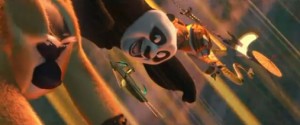 He’s baaaack, and this time it’s…awesome.
He’s baaaack, and this time it’s…awesome.
What better way is there to pander to this summer’s moviegoers? Bring back one of the most im-Po-rtant pandas in the world. No, it’s not Chi Chi, Ling Ling or Hsing Hsing but the star of Kung Fu Panda 2 (KFP2; aka KFP2: The Kaboom of Doom), Po, who is one half of Christopher Robin’s famous toy bear (Winnie the Pooh, for those not familiar) and one whole lot of kung fu panda that is back to save animal kung fu-dom.
For any of us that have learned martial arts, whether traditionally or today’s way, Kung Fu Panda (KFP) offered many different emotional beats; my favorite being the elation that Po felt when he became ru men zi di, which in mandarin Chinese refers to that moment when you “officially” become your shifu’s real student. KFP2’s director Jennifer Yuh Nelson exclusively shares with Black Belt that similar moments are infused into the sequel, one of which is an important concept that children should be aware of, something that she knows is close to my heart, one’s chi (qi), the practice of which gave me the power to overcome cystic fibrosis and walk 3,000 miles across America.
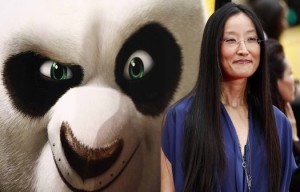 “Chi is the thing that can bring out your achievement in martial arts,” the South Korean born Yuh avers. “It makes you do things you really ought not to be able to do. And that is also what makes Po an interesting character because you think he can’t do what he does, but he does and it’s that underlying factor, his internal strength. This is something that can inspire us all to do something amazing.
“Chi is the thing that can bring out your achievement in martial arts,” the South Korean born Yuh avers. “It makes you do things you really ought not to be able to do. And that is also what makes Po an interesting character because you think he can’t do what he does, but he does and it’s that underlying factor, his internal strength. This is something that can inspire us all to do something amazing.
“One thing we tried to avoid was to show that kung fu was just about punching people, it’s a very righteous process. We get into kung fu to better ourselves internally and make sure that you’re grounded and find that inner peace, be the best that you can be and a big part of that is to tap into your inner strength, your chi. It purveys throughout the film, it’s not about how astute you are with skill but the internal strength that drives it.”
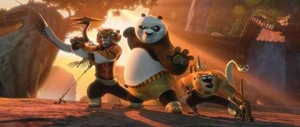 So what does Po need his chi for in KFP2? In a fortune cookie, as compared to a nutshell, after Po (Jack Black) was unexpectedly chosen to fulfill an ancient prophecy and study kung fu under the lone wolf Master Shifu (Dustin Hoffman) to become the The Dragon Warrior, Po and his Furious Five mates, Tigress (Angelina Jolie), Crane (David Cross), Mantis (Seth Rogen), Viper (Lucy Liu) and Monkey (Jackie Chan) must once again face pandemonium.
So what does Po need his chi for in KFP2? In a fortune cookie, as compared to a nutshell, after Po (Jack Black) was unexpectedly chosen to fulfill an ancient prophecy and study kung fu under the lone wolf Master Shifu (Dustin Hoffman) to become the The Dragon Warrior, Po and his Furious Five mates, Tigress (Angelina Jolie), Crane (David Cross), Mantis (Seth Rogen), Viper (Lucy Liu) and Monkey (Jackie Chan) must once again face pandemonium.
This time they travel across China to fight the hyper intelligent and lethal, Lord Shen (Gary Oldman) who plans to use a secret, unstoppable weapon to conquer China and destroy kung fu. To succeed, Po look to his past to uncover the secrets of his mysterious origins and find inner strength.
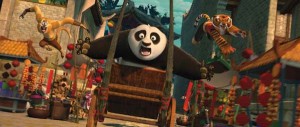 KFP2 is not as touching as the first film, as the filmmakers try to create more of a meaningful banter between Po and his po’ father, the noodle-obsessed goose Mr. Ping (James Hong) who finally breaks the news that he is not his real father. This goose-tale comes across too much like The Jerk (1979), where the white boy character played by Steve Martin has black parents and is also told by his parents after reaching adulthood that they aren’t his real parents.
KFP2 is not as touching as the first film, as the filmmakers try to create more of a meaningful banter between Po and his po’ father, the noodle-obsessed goose Mr. Ping (James Hong) who finally breaks the news that he is not his real father. This goose-tale comes across too much like The Jerk (1979), where the white boy character played by Steve Martin has black parents and is also told by his parents after reaching adulthood that they aren’t his real parents.
Mr. Ping comes across more like a Chinese Amah with a rustic voice than an assured father that took on the responsibility of raising an orphaned panda. It’s Ping’s hat that makes him look similar to a granny with knitting needles stuck in his hat than a cook with chopsticks in the hat. At least the news is no big surprise to Po as recently he’s been getting a sense of morbid fear that somehow Lord Shen is also an important player in the past, and it is Shen that is trying to make a jerk out of Po.
Indeed in KFP2, Po’s universe is modeled after the Chinese folklore world of Jiang Hu (“rivers and lakes”). This alternative society is made up of beggars, martial heroes, martial arts villains and outcasts who coexist with normal society but live by their own laws, systems of brotherhood and morality code of ethics.
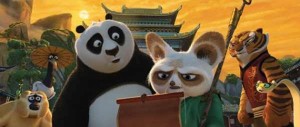 Furthermore, although from a historical sense it would have been cool to model the Fearless Five after the Five Animal Styles of Shaolin (tiger, snake, leopard, white crane, dragon) as created by Jue Yuen, Li Sou and Bai Yu-feng during the 1200’s, the filmmakers opted in KFP to make the leopard evil, use the dragon as a symbolic mythical warrior eventually found in Po, and replace them with two other animal styles; monkey and praying mantis, created in the 1800’s by Kou Zi and Wang Lang in the mid-1600s, respectively.
Furthermore, although from a historical sense it would have been cool to model the Fearless Five after the Five Animal Styles of Shaolin (tiger, snake, leopard, white crane, dragon) as created by Jue Yuen, Li Sou and Bai Yu-feng during the 1200’s, the filmmakers opted in KFP to make the leopard evil, use the dragon as a symbolic mythical warrior eventually found in Po, and replace them with two other animal styles; monkey and praying mantis, created in the 1800’s by Kou Zi and Wang Lang in the mid-1600s, respectively.
The new super-villain, Lord Shen, was undoubtedly a challenge. Shen is a peacock and is obviously a bird that is not known for its fighting behavior or self defense strategies. And of course there is no peacock style of kung fu. The filmmakers found his inspiration for Shen’s kung fu from the Beijing Olympics.
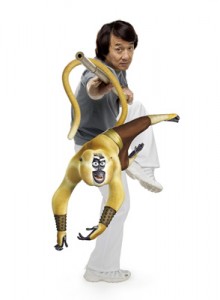 “We tried to incorporate the animal’s attributes and find inspiration for his style using different horizons,” Yuh explains. “For example, he uses lot of weapons because he doesn’t know his own strength. We also wanted him to make him slightly spooky in the way he fights. Although we incorporated some wu shu, most of our inspiration came from watching rhythmic gymnastics at the Olympics from the tools they use during their floor events. They’re great with hoops, clubs, ribbons, have fantastic timing with those things, great poses and phenomenal elasticity and flexibility. It was inspiring to work that into the peacock, and make him an even more unpredictable but lethal opponent.”
“We tried to incorporate the animal’s attributes and find inspiration for his style using different horizons,” Yuh explains. “For example, he uses lot of weapons because he doesn’t know his own strength. We also wanted him to make him slightly spooky in the way he fights. Although we incorporated some wu shu, most of our inspiration came from watching rhythmic gymnastics at the Olympics from the tools they use during their floor events. They’re great with hoops, clubs, ribbons, have fantastic timing with those things, great poses and phenomenal elasticity and flexibility. It was inspiring to work that into the peacock, and make him an even more unpredictable but lethal opponent.”
Although there is more action in KFP2 than the first, Yuh is adamant in pointing out the important theme of the film. “It’s about inner peace and the true strength that comes from within,” she stresses. “If you have this thing called chi, you can do anything. I’d like children to watch this film and feel empowered, because everyone goes through a lot of bad things in their lives, a lot of challenges in their lives, and so with such inner strength they can do a great deal.”